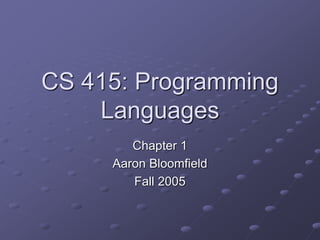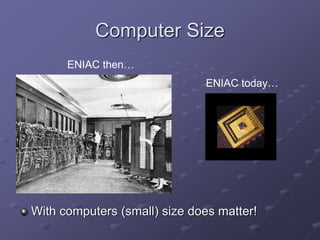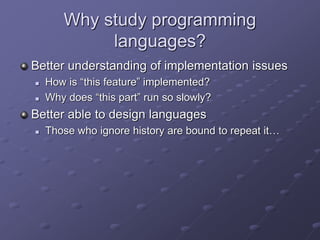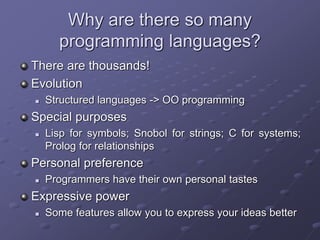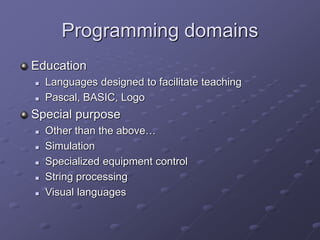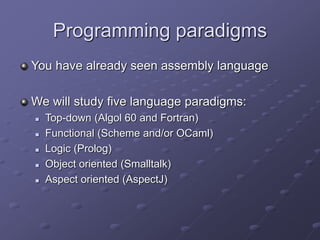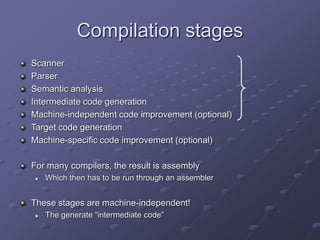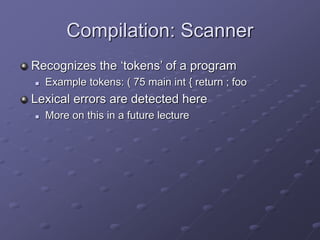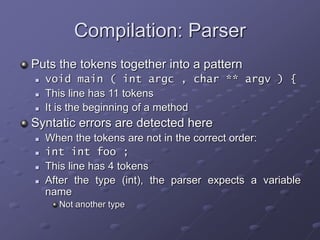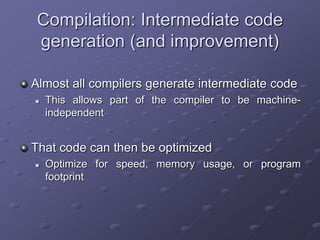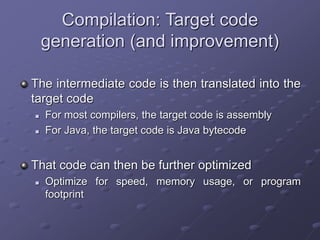02-chapter-1.ppt
- 1. CS 415: Programming Languages Chapter 1 Aaron Bloomfield Fall 2005
- 2. The first computers Scales ŌĆō computed relative weight of two items ’ü« Computed if the first itemŌĆÖs weight was less than, equal to, or greater than the second itemŌĆÖs weight Abacus ŌĆō performed mathematical computations ’ü« Primarily thought of as Chinese, but also Japanese, Mayan, Russian, and Roman versions ’ü« Can do square roots and cube roots
- 3. Stonehenge
- 4. Computer Size ENIAC thenŌĆ” ENIAC todayŌĆ” With computers (small) size does matter!
- 5. Why study programming languages? Become a better software engineer ’ü« Understand how to use language features ’ü« Appreciate implementation issues Better background for language selection ’ü« Familiar with range of languages ’ü« Understand issues / advantages / disadvantages Better able to learn languages ’ü« You might need to know a lot
- 6. Why study programming languages? Better understanding of implementation issues ’ü« How is ŌĆ£this featureŌĆØ implemented? ’ü« Why does ŌĆ£this partŌĆØ run so slowly? Better able to design languages ’ü« Those who ignore history are bound to repeat itŌĆ”
- 7. Why are there so many programming languages? There are thousands! Evolution ’ü« Structured languages -> OO programming Special purposes ’ü« Lisp for symbols; Snobol for strings; C for systems; Prolog for relationships Personal preference ’ü« Programmers have their own personal tastes Expressive power ’ü« Some features allow you to express your ideas better
- 8. Why are there so many programming languages? Easy to use ’ü« Especially for teaching / learning tasks Ease of implementation ’ü« Easy to write a compiler / interpreter for Good compilers ’ü« Fortran in the 50ŌĆÖs and 60ŌĆÖs Economics, patronage ’ü« Cobol and Ada, for example
- 9. Programming domains Scientific applications ’ü« Using the computer as a large calculator ’ü« Fortran and friends, some Algol, APL ’ü« Using the computer for symbol manipulation ’ü« Mathematica Business applications ’ü« Data processing and business procedures ’ü« Cobol, some PL/1, RPG, spreadsheets Systems programming ’ü« Building operating systems and utilities ’ü« C, PL/S, ESPOL, Bliss, some Algol and derivitaves
- 10. Programming domains Parallel programming ’ü« Parallel and distributed systems ’ü« Ada, CSP, Modula, DP, Mentat/Legion Artificial intelligence ’ü« Uses symbolic rather than numeric computations ’ü« Lists as main data structure ’ü« Flexibility (code = data) ’ü« Lisp in 1959, Prolog in the 1970s Scripting languages ’ü« A list of commands to be executed ’ü« UNIX shell programming, awk, tcl, Perl
- 11. Programming domains Education ’ü« Languages designed to facilitate teaching ’ü« Pascal, BASIC, Logo Special purpose ’ü« Other than the aboveŌĆ” ’ü« Simulation ’ü« Specialized equipment control ’ü« String processing ’ü« Visual languages
- 12. Programming paradigms You have already seen assembly language We will study five language paradigms: ’ü« Top-down (Algol 60 and Fortran) ’ü« Functional (Scheme and/or OCaml) ’ü« Logic (Prolog) ’ü« Object oriented (Smalltalk) ’ü« Aspect oriented (AspectJ)
- 13. Programming language history Pseudocodes (195X) ŌĆō Many Fortran (195X) ŌĆō IBM, Backus Lisp (196x) ŌĆō McCarthy Algol (1958) ŌĆō Committee (led to Pascal, Ada) Cobol (196X) ŌĆō Hopper Functional programming ŌĆō FP, Scheme, Haskell, ML Logic programming ŌĆō Prolog Object oriented programming ŌĆō Smalltalk, C++, Python, Java Aspect oriented programming ŌĆō AspectJ, AspectC++ Parallel / non-deterministic programming
- 14. Compilation vs. Translation Translation: does a ŌĆśmechanicalŌĆÖ translation of the source code ’ü« No deep analysis of the syntax/semantics of the code Compilation: does a thorough understanding and translation of the code A compiler/translator changes a program from one language into another ’ü« C compiler: from C into assembly An assembler then translates it into machine language ’ü« Java compiler: from Java code to Java bytecode The Java interpreter then runs the bytecode
- 15. Compilation stages Scanner Parser Semantic analysis Intermediate code generation Machine-independent code improvement (optional) Target code generation Machine-specific code improvement (optional) For many compilers, the result is assembly ’ü« Which then has to be run through an assembler These stages are machine-independent! ’ü« The generate ŌĆ£intermediate codeŌĆØ
- 16. Compilation: Scanner Recognizes the ŌĆśtokensŌĆÖ of a program ’ü« Example tokens: ( 75 main int { return ; foo Lexical errors are detected here ’ü« More on this in a future lecture
- 17. Compilation: Parser Puts the tokens together into a pattern ’ü« void main ( int argc , char ** argv ) { ’ü« This line has 11 tokens ’ü« It is the beginning of a method Syntatic errors are detected here ’ü« When the tokens are not in the correct order: ’ü« int int foo ; ’ü« This line has 4 tokens ’ü« After the type (int), the parser expects a variable name Not another type
- 18. Compilation: Semantic analysis Checks for semantic correctness A semantic error: foo = 5; int foo; In C (and most languages), a variable has to be declared before it is used ’ü« Note that this is syntactically correct As both lines are valid lines as far as the parser is concerned
- 19. Compilation: Intermediate code generation (and improvement) Almost all compilers generate intermediate code ’ü« This allows part of the compiler to be machine- independent That code can then be optimized ’ü« Optimize for speed, memory usage, or program footprint
- 20. Compilation: Target code generation (and improvement) The intermediate code is then translated into the target code ’ü« For most compilers, the target code is assembly ’ü« For Java, the target code is Java bytecode That code can then be further optimized ’ü« Optimize for speed, memory usage, or program footprint

